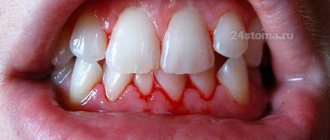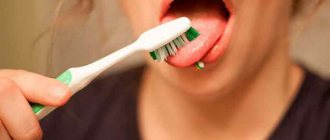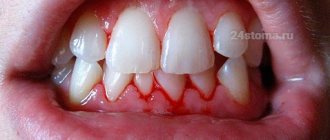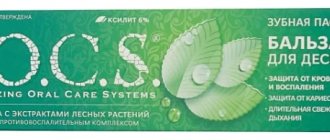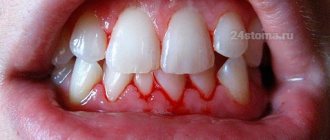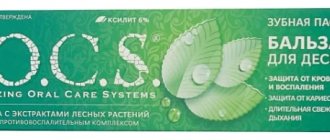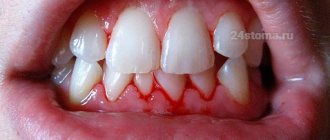Use of mumiyo for the treatment of periodontal disease
Periodontal disease is a common disease that can even lead to tooth loss. But not everyone knows how effective mumiyo is for periodontal disease. But this safe natural remedy can help in the fight against the disease in question even in its last stages! It is only important to choose the right mummy and use it correctly.
An effective treatment regimen for periodontal disease using mumiyo, honey and milk
You need to take 0.2 g of mumiyo and dissolve it in warm milk and honey, maintaining a ratio of 1:20. You should drink this “cocktail” twice a day for 25 days (and once before bed). And to ensure maximum effect, it is additionally recommended to carry out local treatment of gums using a 5% aqueous solution of the product in question - simply apply this solution to damaged gums using a cotton swab.
First, due to periodontal disease, the sensitivity of the gums changes, then the gums swell and begin to hurt, and over time they bleed, and the teeth become loose. But the use of mumiyo for periodontal disease can effectively solve the problem at any stage of the disease. However, it should be noted that you should not use tablets for treatment, but exclusively natural mumiyo.
Our store
How to treat periodontal disease and periodontitis
With the exception of local periodontitis caused by traumatic factors, both diseases are completely incurable, but timely diagnosis and proper treatment can transform the disease into a stable state and preserve teeth for many years.
The main thing in the treatment of periodontitis
- If there are traumatic factors, it is important to eliminate them as quickly as possible
- solve existing orthodontic problems
- Since in the case of periodontitis, poor hygiene is the main cause of the disease, it is necessary to carefully observe daily hygiene and, on the recommendation of a doctor, do professional oral hygiene
- lead a healthy lifestyle
Read the article To prevent periodontitis, do professional hygienic teeth cleaning 2 times a year.
If, in case of gingivitis, professional hygiene with the use of ultrasonic cleaning will help normalize the situation with the gums, then in the case of the formation of subgingival deposits and periodontal pockets, treatment using the Vector device is recommended, and possibly surgical intervention (closed/open curettage and flap operations).
Read the article Prevention and effective treatment with the Vector device
The main thing in the treatment of periodontal disease
- since often insufficient blood supply to periodontal tissue is associated with cardiovascular and endocrine diseases, it is necessary to begin treatment with a specialized specialist
- Hydromassage with an irrigator, finger massage of the gums and physiotherapy will help improve blood circulation
- it is very important to lead a healthy lifestyle
- Special attention should be paid to oral hygiene so that periodontal disease is not accompanied by inflammatory processes, which can significantly accelerate the destruction of bone tissue.
Since periodontitis and periodontal disease are accompanied by a loss of bone tissue that holds the teeth, lost teeth should be restored without delay so as not to create an increased chewing load on the remaining ones and to prevent free space in the dentition.
To stabilize the position of the teeth, splinting may be required, which will distribute the load more evenly across the dentition.
Recipes for using mumiyo for periodontal disease
Mumiyo perfectly helps with periodontal disease due to its unique anti-inflammatory, antibacterial and wound-healing properties. This product has a positive effect on gum tissue, relieves inflammation, destroys pathogenic bacteria, strengthens gums and improves tissue metabolism. Therefore, using natural mumiyo for treatment, you can achieve an amazing positive effect - the most important thing is to correctly prepare the medicine based on it. And we will tell you how to do this below.
An effective recipe for the prevention and treatment of periodontal disease in the initial stages
There is another way to improve the condition of your gums, get rid of bleeding and avoid dental problems - you need to rinse your mouth with a solution prepared based on mumiyo. Making such a solution is very simple - mix 5 g of Altai mumiyo with 100 ml of warm water, shake it thoroughly and rinse your mouth regularly in the morning and before bed. Moreover, the used solution must be spat out - under no circumstances should it be swallowed.
Electrophoresis using a 4% solution of mumiyo
An effective way to treat periodontal disease is also electrophoresis using a 4% mumiyo solution. In this case, the current strength should vary within 2 - 5 μA, and the duration of the procedure will be 20 minutes. Moreover, for a complete cure, the patient must complete the entire course - 10 procedures, 1 per day. And these procedures should be carried out by a professional doctor.
Mumiyo for pain in the gums
Also, to relieve pain in the gums, you can use ordinary dry mumiyo, after kneading it with your fingers. In this case, you will need to place a small piece of a natural product on the affected gum and, without rubbing it or dissolving it, wait 20 minutes - during this time the mumiyo will soften naturally and be absorbed into the affected tissue, restoring them and destroying pathogenic bacteria.
Thus, it is obvious that there are many recipes for natural medicines based on mumiyo designed to combat periodontal disease. And if you encounter the first signs of the disease, hurry to use these recipes so as not to lose absolutely healthy teeth due to gum disease.
Periodontitis is an inflammatory process in periodontal tissues
Periodontitis begins with inflammation of the gums - gingivitis, which is caused by microbes from plaque. The gums become red, swollen, and may bleed when brushing your teeth, but this condition is reversible and after normal hygiene is restored, everything returns to normal.
If no action is taken at the stage of gingivitis, the inflammation penetrates under the gum, the ligament that holds the tooth in the socket is destroyed, bone tissue begins to become arthophic, and periodontal “pockets” are formed filled with soft plaque and tartar. In the absence of treatment, the destruction of periodontal tissue can proceed to the apex of the root and the inflammation will end only after the removal of the causative tooth.
Depending on the severity, the disease manifests itself as follows:
- Soreness, swelling and bleeding of the gums.
- Exposure of the roots of the teeth and the appearance of tooth mobility.
- Discharge from periodontal pockets, accompanied by an unpleasant odor or taste in the mouth.
The rate of development of periodontitis depends on the composition of the microbial flora, the patient’s immunity, genetic predisposition, and the presence or absence of treatment. Unlike periodontal disease, which always affects a group of teeth, periodontitis can be limited to 1-2 teeth, in the case of:
- An “inflated” filling, which creates an increased chewing load that is transmitted to the periodontal tissue.
- The “overhanging” edge of a filling or crown, which irritates the gums and makes hygiene difficult.
- “Overload” of periodontal tissues caused by uncomfortable orthopedic structures or problems with bite.
Usually, eliminating the traumatic factor stops the destruction process and the bone tissue can partially recover.
Antibiotics
Since the treatment is based on an antimicrobial method, taking antibiotics is inevitable for this disease. For periodontal disease, broad-spectrum antibiotics are usually prescribed, as they can destroy the maximum number of pathogenic bacteria.
Before starting treatment with tablets, it is necessary to do a special bacterial test to determine the sensitivity of bacteria to the prescribed antibiotic. If the patient does not tolerate antibiotics well, the doctor needs to find an alternative method of treatment. That is why it is strictly forbidden to self-medicate and prescribe medications on your own.
Modern antibiotics come in various forms. It can be:
- tablets for oral administration;
- capsules for systemic treatment;
- gels for local use;
- special antiseptic solutions for rinsing the mouth.
Antibiotics may also be present in medicated toothpastes intended for the treatment of periodontal disease.
Despite such a variety of dosage forms, antibiotics are most effective in the form of tablets and capsules for internal use. In this case, they influence the entire body, allowing you to achieve maximum effect.
Most often, when treating periodontal disease, dentists prescribe the drugs metronidazole and doxycycline . They act specifically on those microorganisms that cause the disease. In combination with chlorhexidine, these drugs can almost completely get rid of the symptoms of periodontal disease.
Lincomycin
In recent years, treatment of periodontal disease with lincomycin has become increasingly common. This is a new generation antimicrobial drug with a broad spectrum of action. Lincomycin has a bactericidal effect.
Lincomycin is also prescribed in the presence of infectious diseases of the joints, bones (arthritis, osteomyelitis), respiratory tract (pharyngitis, tracheitis, pneumonia, bronchitis, sinusitis), soft tissues and skin (furunculosis, abscess, erysipelas, mastitis). The therapeutic dose is set by the doctor, depending on the patient’s condition and the severity of the disease in each specific case.
Usually this drug is taken for up to two weeks, but in exceptional cases the duration of use can be extended. Under no circumstances should you self-prescribe lincomycin! At a minimum, you can “earn” dysbacteriosis, and at a maximum – serious damage to the kidneys and liver. Therefore, treatment with lincomycin should be carried out only as directed by a dentist, who will select an effective and at the same time safe dose of the drug.
Trichopolum
The modern antimicrobial drug trichopolum is often used for periodontal disease. Trichopolum is also a broad-spectrum antibiotic, so it is used not only in dentistry. In particular, Trichopolum is prescribed for amoebiasis, trichomoniasis, giardiasis, vaginitis, urethritis, infectious diseases of bones, joints, central nervous system, bacterial pneumonia and other diseases.
Since Trichopolum has a wide spectrum of action, it effectively fights all known bacteria that are involved in the occurrence of the disease. Therefore, you should not be alarmed if the doctor prescribes you this particular antibiotic - it is used not only in general therapy, but also in the treatment of dental diseases, which include periodontal disease.
Not recommended products for periodontal disease
- sweets (sweets, chocolate, desserts, cakes, cookies) – it contributes to the destruction of hard and soft tissues of the oral cavity;
If you have periodontal disease, you should not eat viscous sweets (marshmallow, caramel, toffee), which stick to the tooth enamel, and the remains of such food are difficult to clean out with a brush. Such products provoke the formation of plaque and carious lesions.
- flour (buns, cookies, white bread) - these products are better replaced with bread, products made from wholemeal flour;
- fast food, soda, chips, crackers - foods that are poorly digested create problems in the gastrointestinal tract, which definitely affects the condition of the teeth;
- black tea and coffee - they negatively affect the condition of tooth enamel and soft tissues.
What vitamins should I take if I have periodontal disease?
To combat gum damage, it is necessary to saturate the body with vitamins. Here are the most important groups:
- Vitamin A - helps restore the epithelium, activates regeneration processes. A large amount of vitamin A is found in broccoli, carrots, pumpkin, blueberries, black currants, apricots, spinach, and liver.
- Vitamin E – is directly involved in the metabolic processes of the body. It is found in corn, vegetable oil, and rose hips.
- Vitamin K – takes part in blood clotting processes. Contained in spinach, parsley, cilantro, dill, cauliflower, green tomatoes. It is very important if it is necessary to prevent bleeding gums - a clear and first sign of periodontal disease.
- Vitamin B6 – helps strengthen blood vessels, improves mineral metabolism in the jaw bones. Contained in yeast, grains, legumes.
Along with healthy foods that contain vital vitamins, dentists recommend taking vitamin complexes - a ready-made set of useful components that will help prevent the development of periodontal disease and significantly improve health.


